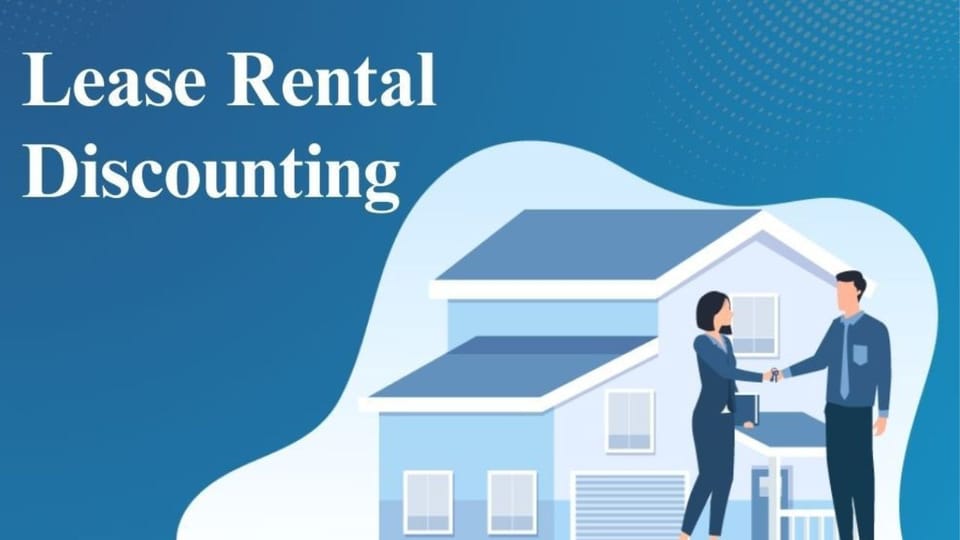Lease Rental Discounting (LRD): Features and Benefits

Lease Rental Discounting (LRD) is a financial product designed to help property owners or landlords unlock the value of their rental income by leveraging future rental payments to secure immediate funding. This form of financing is particularly useful for commercial real estate owners who have long-term lease agreements with tenants. By pledging their rental income streams as collateral, landlords can access funds for their business or personal needs without needing to sell the property or take on traditional forms of debt.
In this article, we will explore Lease Rental Discounting in detail, including its features, benefits, eligibility criteria, associated charges, and the step-by-step process of how to apply for an LRD loan.
What is Lease Rental Discounting (LRD)?
- Lease Rental Discounting (LRD) is a financial arrangement where a property owner pledges the future rental income from a property as collateral to secure a loan from a financial institution. Essentially, the lender assesses the value of the property based on its rental income and provides a loan against the anticipated cash flow from the rental payments over the term of the lease.
- In LRD, the primary source of repayment for the loan is the rental income that the property owner will receive over a pre-determined period. This arrangement is most commonly used in commercial properties, such as office spaces, retail outlets, and industrial units, where rental payments are generally stable and predictable over the long term.
LRD Full Form:
- The full form of LRD is Lease Rental Discounting. It is a type of term loan offered by banks and financial institutions against rental receipts derived from lease contracts with tenants. The loan amount is based on the discounted value of the future lease receivables and is typically used by property owners to raise funds for various purposes.
Features of Lease Rental Discounting:
- Loan Against Rental Income: Unlike traditional loans, where the property itself serves as collateral, LRD loans are based on the future rental income. This makes it easier for landlords to access funding without having to sell or transfer ownership of the property.
- Tenure Linked to Lease Agreement: The loan repayment tenure is typically linked to the remaining lease period with the tenant. If the lease has 5 years left, the loan tenure might be structured for a similar duration.
- Loan Amount Based on Rent Roll: The loan amount sanctioned is primarily determined by the property’s rental income. Lenders usually offer a percentage of the future rent as the loan amount.
- Security and Guarantee: The future rental income serves as the primary security, while the property itself may also be considered as collateral. In some cases, the tenant’s security deposit or a personal guarantee from the property owner may also be required.
- Fixed or Variable Interest Rates: The interest rates on LRD loans can be either fixed or variable. Lenders generally offer competitive rates, depending on the property’s location, the tenant’s creditworthiness, and the stability of rental income.
- No Requirement for Prepayment: LRD loans typically do not require upfront payments or down payments from the property owner. Instead, the loan is repaid through monthly installments, which are derived from the rental income received.
- Option to Refinance: If the property owner has a change in circumstances or if market conditions improve, refinancing options may be available to adjust the loan’s terms or interest rate.
Benefits of Lease Rental Discounting
- Access to Liquidity Without Selling Property: LRD allows property owners to access significant capital without having to sell their property. This makes it an ideal option for individuals or businesses who wish to retain ownership of their real estate but need immediate funds.
- Lower Interest Rates: Since the loan is secured by the future rental income and is considered a low-risk investment for the lender, interest rates on LRD loans are typically lower than those on unsecured loans or personal loans.
- Flexible Loan Amounts: Lenders assess the future rental income to determine the loan amount, which means that property owners can receive substantial loans depending on the size of the rental income stream. In some cases, the loan can be up to 80% of the future rental income, depending on the lender’s policies.
- Long-Term Financing Option: LRD is generally considered a long-term financing solution, which can provide property owners with funds for expansion, debt repayment, or other business needs without having to disrupt their ongoing rental income.
- Quick and Simple Application Process: The process of applying for an LRD loan is generally less complicated than other forms of real estate financing. As the loan is based on the property’s rental income, documentation requirements are often more straightforward.
- Tax Benefits: Interest paid on LRD loans may be tax-deductible for property owners, depending on the jurisdiction and the purpose of the loan. This can further improve the financial attractiveness of taking out an LRD loan.
Eligibility for Lease Rental Discounting
While LRD is a useful financial product for many property owners, there are specific eligibility criteria that need to be met. Below are the common eligibility conditions:
- Property Type: The property must be a commercial real estate asset, such as office buildings, shopping malls, industrial spaces, or retail outlets. Residential properties are typically not eligible for LRD.
- Lease Agreement: A valid lease agreement must be in place with a reliable tenant. The lease term should ideally be for at least 3-5 years, with a stable rental income.
- Tenant Profile: The tenant’s financial credibility plays a critical role in determining the loan’s approval. The more stable and reputable the tenant, the higher the chances of loan approval. Long-term tenants with a strong track record are generally preferred.
- Ownership of Property: The applicant should be the legal owner of the property. The property can be mortgaged or encumbered, but the lender will typically evaluate the existing liabilities before approving an LRD loan.
- Age and Financial Stability of the Borrower: Lenders may impose age restrictions (usually between 25-65 years of age) and require the property owner to demonstrate financial stability, including a steady income or a strong business track record.
- Minimum Rent Criteria: Lenders often have a minimum rent threshold that must be met for the property to be eligible. For example, the rental income might need to be at least INR 1 lakh per month or a similar benchmark depending on the lender and location.
Fees Associated with Lease Rental Discounting
Like any financial product, LRD loans come with associated fees. These can vary depending on the lender and the terms of the loan, but some common fees include:
- Processing Fees: This is a one-time fee charged by the lender for processing the loan application. It typically ranges from 1% to 4% of the loan amount.
- Valuation Fees: Some lenders require a professional valuation of the property to determine its market value and rental potential. These fees can vary but generally range from INR 5,000 to INR 20,000.
- Legal Fees: Legal charges may apply to ensure the lease agreement is enforceable and the property is clear of encumbrances. These costs will depend on the legal firm involved.
- Prepayment Charges: If the borrower decides to repay the loan before the agreed-upon term, there may be prepayment penalties. This could range from 2% to 3% of the outstanding principal amount.
- Late Payment Fees: In case of delayed repayments, the lender may charge a penalty, typically in the range of 2% to 4% of the overdue amount.
- Insurance: Some lenders may require borrowers to insure the property against natural disasters, fire, or damage. The cost of insurance will depend on the property’s value.
How to Apply for Lease Rental Discounting (LRD)?
Applying for a Lease Rental Discounting loan involves a straightforward process. Below is a step-by-step guide to help you navigate the application:
- Check Eligibility: Before applying for an LRD loan, ensure that your property meets the eligibility criteria outlined by the lender. The property should have a valid lease agreement with reliable tenants and a stable rental income.
Prepare Documentation: Gather all necessary documents, which may include:
a - Proof of property ownership (title deeds, property tax receipts)
b - Lease agreement with tenants
c - Recent rent receipts
d - Tenant’s credit and financial details (such as business income statements)
e - KYC documents (Aadhaar, PAN, Passport)
f - Financial statements and tax returns of the property owner
g - Property valuation reports (if required)
- Choose the Right Lender: Compare different lenders offering LRD loans to find the one that provides the best terms, interest rates, and processing fees. Most banks and non-banking financial companies (NBFCs) offer LRD products.
- Submit the Application: Complete the application form, provide all required documentation, and submit it to the lender. Some lenders allow online applications for convenience.
- Loan Assessment and Approval: The lender will assess the property’s rental income, tenant profile, lease term, and other factors. A property valuation may also be conducted. If the loan is approved, the lender will provide a sanction letter outlining the loan amount, terms, and interest rates.
- Sign the Loan Agreement: After loan approval, you will be required to sign a loan agreement that outlines the terms and conditions, repayment schedule, and other pertinent details.
- Loan Disbursement: The loan amount will be disbursed once the paperwork is complete, typically via bank transfer. Repayment will begin according to the agreed-upon schedule, usually with monthly installments.
FAQs:
What is The full form of LRD?
- The full form of LRD is Lease Rental Discounting.
How does lease rental discounting differ from a mortgage?
- Lease rental discounting (LRD) is a type of loan where the lender extends credit based on the rental income generated by the property. In contrast, a mortgage is a loan secured by real estate, typically used to purchase the property.
What is meant by lease rental discounting?
- Lease Rental Discounting (LRD) is a type of loan where you can borrow money against your future rental income. If you own a property that generates regular rental income, you can opt for LRD to access funds. The loan amount depends on the discounted value of your rental income and the market value of the property.
Can I prepay my lease rental discounting loan?
- Yes, prepayment of a lease rental discounting loan is generally allowed, but it's essential to check the terms and conditions of your specific loan agreement.
Is lease rental discounting available for residential properties?
- Lease rental discounting is typically available for commercial properties rather than residential properties. Lenders prefer commercial properties because they generate steady rental income.
What is the purpose of LRD?
- Lease Rental Discounting (LRD) is a term loan provided against commercial properties that generate income. The loan is based on the concept that the fixed rental income from your leased property can be used as collateral to quickly secure funds.
How is LRD eligibility calculated?
- We provide Lease Rental Discounting (LRD) to property owners who are receiving rent from their leased premises. The loan eligibility is determined based on the discounted value of future rental cash flows and the property's current market value. LRD is a term loan that can be utilized for both personal and business-related financial needs.
What happens if the tenant vacates the property before the lease term ends?
- If the tenant vacates the property before the lease term ends in a lease rental discounting scenario, it may affect the rental income. However, the borrower is still responsible for repaying the loan as per the agreed terms.
How is the loan amount in lease rental discounting determined?
- The loan amount in lease rental discounting is determined based on the rental income generated by the property. Lenders typically consider factors such as the lease terms, rental amount, and the creditworthiness of the tenant.
Are there any tax benefits associated with lease rental discounting?
- Yes, there may be tax benefits associated with lease rental discounting. Interest paid on the loan may be tax-deductible as a business expense, depending on the local tax regulations. Additionally, rental income earned from the property may also have tax implications. It's advisable to consult with a tax advisor for personalized guidance.
What is the benefit of LRD?
- Leverage Rental Income: LRD enables property owners to access funds by leveraging their rental income without needing to sell the property. They can continue earning rental income while using the property as collateral for the loan.
- Flexible Repayment: Lease Rental Discounting offers property owners flexible repayment options, making it easier to manage the loan alongside their financial obligations.
What is the maximum limit of LRD?
- LRD loans in India offer property owners up to 80% of their future rent receivables as the loan amount, with a repayment tenure of up to 15 years. This allows property owners to unlock substantial funds based on their rental income over an extended period.
We hope that you like this content and for more such content Please follow us on our social site and YouTube and subscribe to our website.
Manage your business cash flows and payable/receivables using our Bahi Khata App




Comments ()